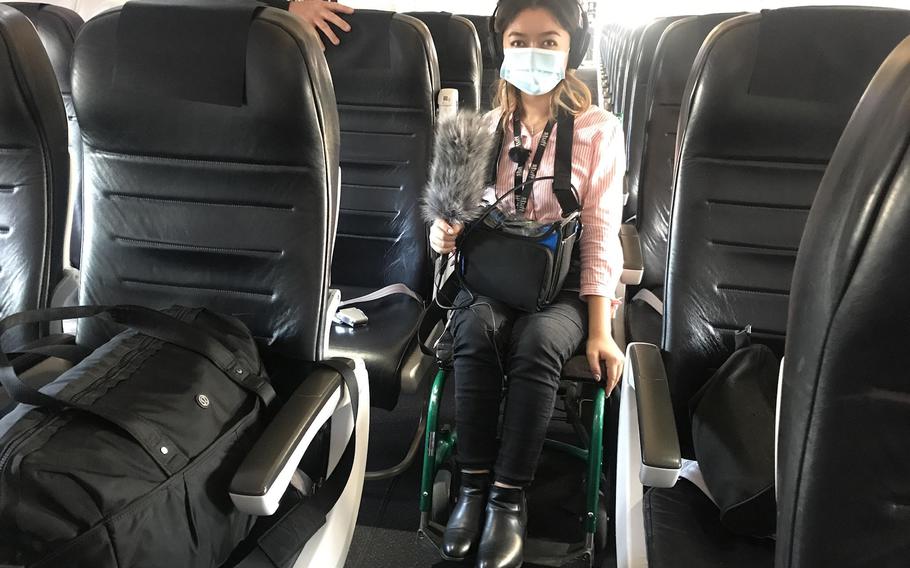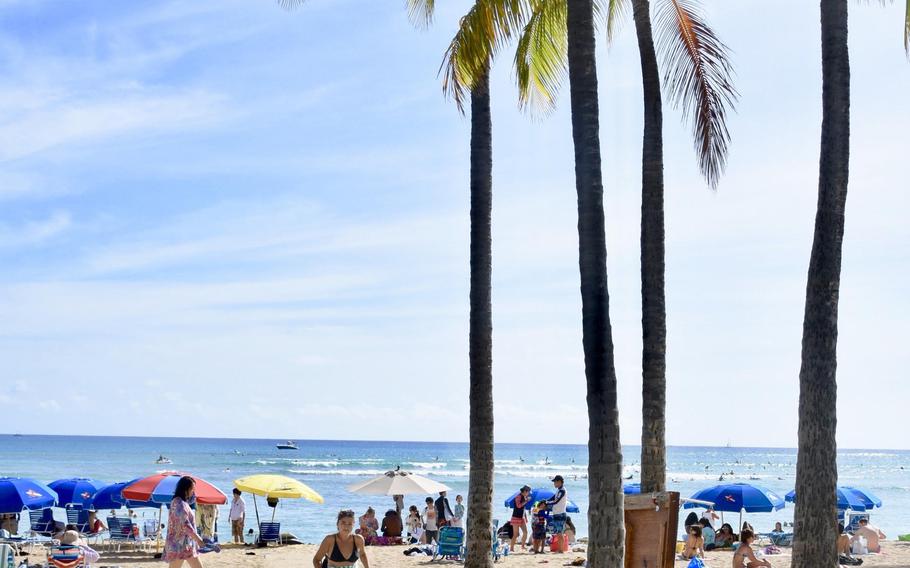
As airplane aisles are too narrow for her wheelchair, Olivia Shivas borrows one to board the plane. (Olivia Shivas/For The Washington Post)
I could feel my world growing smaller when I was diagnosed with Crohn's disease, a chronic illness that affects the digestive tract. In May 2020, we were in the midst of a global shutdown - and even before that, symptoms of my then-uncontrolled, unnamed illness had led me to stay home more often than not.
After growing up dreaming of the day I would have the independence to explore the globe, I felt that independence quickly slip away as my doctors explained the many new medications and lifestyle changes my diagnosis would entail.
But as the world started to reopen last year, I found myself drawn to the same budget travel websites with which I would book trips in the past. And somehow, I found myself clicking "buy."
One in four American adults live with a disability, and 60% have at least one chronic illness. As travel continues to ramp up, more people like me will have questions about how to navigate it with their circumstances.
Through online communities, travelers with disabilities or chronic illnesses share tips and support for making the experience more accessible and alleviate fears that others might have when planning trips.
"When I hear back from people who book that ticket, take a chance . . . it's always exciting," said Jamie Knowles-Griffiths, who writes about traveling with Crohn's disease on her blog.
Getting to a place to travel again has been a journey in itself. I spent months overcoming a lifelong fear of needles to learn to self-inject medication every two weeks so that any future travel I wanted to pursue wouldn't be hindered by infusion dates and clinic visits.
People with disabilities or illness cope with an added layer of worry and logistics - and that's even more complicated during a pandemic for those who are immunocompromised. For me, the main concerns are finding a way to keep my medication refrigerated throughout my stay, dealing with a potential flare-up of my symptoms and keeping my immunocompromised system healthy.
I talked to some well-traveled experts on how to make travel more accessible and connect with local communities.
Be your own travel agent
In the podcast "What's Wrong With You?", New Zealand journalist Olivia Shivas and her friends discuss their experience navigating the world as wheelchair users. In their episode on disabilities and travel, the podcast team flies across New Zealand to interview a disability advocate and encounter accessibility barriers to travel firsthand.
Shivas is well-traveled and has picked up skills along the way to ensure trips go as smoothly as possible.
"One of the reasons we made the podcast is I love getting advice and helping other disabled people know what's possible," said Shivas, who was born with muscular dystrophy.
Common issues that arise for wheelchair users while traveling include plane aisles being too narrow for their wheelchairs; hotels and attractions that don't meet accessibility needs; and wheelchairs being broken or lost by airlines. The latter is an expensive and life-altering occurrence for people traveling with wheelchairs - more than 15,000 wheelchairs have been damaged or lost by U.S. airlines since 2018 as of June 2021. While public spaces in the United States have to comply with the Americans With Disabilities Act, Shivas says this is more limited in countries without similarly rigorous accessibility policies.
Even the entrance to an Airbnb or hotel being a few inches off the ground can make it inaccessible for a wheelchair, Shivas said.
"But just because the world is badly designed doesn't mean we don't want to see more of it," said Rebecca Dubber, Shivas's co-host and a Paralympian, on the podcast episode.
To meet these challenges, Shivas thoroughly researches and plans each leg of her journey. She reads blogs and reviews by other disabled people, checks out the exterior of buildings on Google Maps (with a keen eye for staircases), and makes sure to request accessible accommodations.
"I am basically my own travel agent," she said.
Unfortunately, this doesn't always ensure a problem-free journey. On the podcast episode, the team discovered that the "accessible" lookout at a castle they visited was only reachable by steep staircases.
Shivas has also had the experience of a wheelchair being damaged while abroad, both by airlines and on the street while touring a new city. However, she was once able to use some quick thinking - and help from a nearby bike shop - to repair a flat tire in Helsinki.
"You kind of have to learn to be creative, adapt and find different solutions," she said.

Thanks to the Americans With Disabilities Act, Olivia Shivas said, beaches in Hawaii have accessible mats for wheelchair users to reach the shoreline on. (Olivia Shivas/For The Washington Post)
Reaching out to locals
In 2014, Marlene Valle traveled to a new country without her family for the first time. Valle, who is deaf, heard many warnings against traveling alone; they told her it was best to have a hearing person accompany her, she remembers.
"I really thought it would be tough for me to travel because how would I navigate, communicate [with people who speak] verbally, how would I catch announcements on certain flights?" she said in American Sign Language.
But travel quickly became her passion. Following the first trip to South Korea in 2014, she started her blog "Deafinitely Wanderlust" and a YouTube account of the same name in 2015 to chronicle her journeys and the stories of people she met in the deaf community across the globe. Valle said she saw no representation of deaf people in the travel industry and wanted to change that.
In 2018, Valle and her partner, who is also deaf, embarked on a year-long journey across Asia.
She considers the biggest hurdles to travel accessibility for deaf people to be a lack of awareness by airlines, tour groups and other travel organizations on how to make their services equitable.
"Sometimes, they'll be like a deer in headlights communicating with you," she said.
In a 2018 blog post, Valle shared an experience where an airline employee in Singapore shouted at her and her travel companion when they asked for the employee to write down what they were saying. Another traveler stepped in, and a different airline employee eventually responded in writing.
"If you feel dehumanized and know that you shouldn't be treated that way, it is okay for you to speak up for yourself," Valle wrote in her blog.
The best way Valle has found to make sure she doesn't miss flight updates or announcements is to download the airline's app and turn on alerts. She also makes sure to confirm the app's information with the departure boards at the airport and check in with gate agents so they will let her know when it's her turn to board.
When planning trips, Valle often reaches out to local deaf community members, who can tell her what to expect in terms of accessibility. Through this, she has picked up signs from sign languages across the world.
Prepare for the worst, but don't let it stop you
Since Knowles-Griffiths was diagnosed with Crohn's disease at 13, she said, it has been "a defining part" of her identity.
"I just had a lifelong passion for travel and tried to never let Crohn's stop me," she said.
But about a decade ago, she experienced a severe flare-up of symptoms that made her question whether she would be able to travel again. She struggled to find any online resources specific to traveling with Crohn's.
"I didn't find a lot of positive resources out there when I was bedridden and looking for inspiration," Knowles-Griffiths said.
Through her blog "Crohnie Travels," Knowles-Griffiths has worked to break down stigma with honest accounts of her experiences traveling and living with Crohn's.
One of the biggest accessibility hurdles she has encountered overseas is bathroom access. Although she usually carries a wallet-size card with information from the Americans With Disabilities Act, this is never a guarantee.
Nearly having her medication confiscated by airport security taught Knowles-Griffiths to always carry a note from her doctor detailing her diagnosis and medical needs, including the exact medications she takes.
Knowles-Griffiths said half of what she packs is often food and medication since her "safe" foods can sometimes be hard to find. She has even shipped ahead protein bars and dairy alternatives to her destination. She also prefers to find accommodations where she can prepare her own food or have a private space to rest if she is experiencing a symptom flare-up.
"People can often be a little bit judgmental and critical when they see someone who has an invisible illness and perceive them as being weak, not as adventurous or not as able to adapt to the culture," she said.
However, she sees every person traveling with a disability as already far outside their comfort zone.
"The only way you can really fulfill your travel desires is by putting it front and forward, and knowing you're going to have to tackle it the whole way, but it's going to be so worth it," Knowles-Griffiths said.